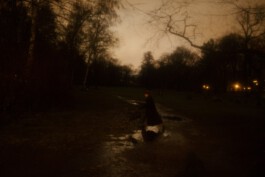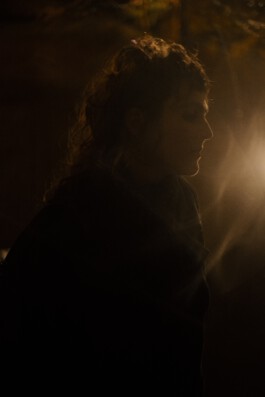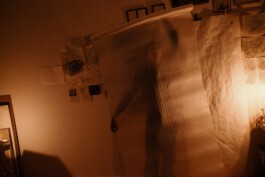overcoming labels: the thoughts between a conversation
excerpts from the conversation project “Seduta Artistica” with additional thoughts by artist Anika Krbetschek and curator Silvia Russo
23. feb.
by silvia russo & anika krbetschek
tw: suicide attempt, no further or explicit descriptions

I am sitting on the floor, on a colorful rug that is just the size of my chair. There is a grape in my hand that has been waiting to be eaten for an hour now, already warm from the heat of my body as I am too invested in talking to get to the point of eating that sweet little grape. In front of me is Silvia. She invited me onto that carpet and gave me the grapes. We met once at a Späti. That day her eyes had the gleam of a new idea.
On that summer day, Silvia decided to invite Anika Krbetschek as the first protagonist of her conversation project. This choice is not arbitrary; Silvia felt a special connection with Anika and wished to deepen her understanding by delving into the depths of her and her art. Usually, artists use art as a means to express themselves, but often this is not enough, maybe.
Only two weeks later, Silvia turns a little room into a conversation zone surrounded by fruits with honey and focaccia from a local bakery. Anika rings the intercom.
What is she thinking right now? Will she be nervous to talk to me more deeply from now on? I think her experiences are so unique and sincere that my time to listen to her is not enough, I wish I had no spatial or temporal limit. Ok, I'll go ahead.
“How do you feel you want to introduce yourself?” Silvia asks Anika straight away and hands her a plate and some of the grapes.
“I guess the starting point for me and all my actions is that I'm a spring-born”, she started. “...and that means that I believe in the beginning. In the heart of a first light, in growth and blossoming."


“I guess the starting point for me and all my actions is that I'm a spring-born”
“I believe in change and for change-making I truly believe in passion, collaboration, and participation”, continued Anika. “...With these comes sensitivity, but also curiosity and emotional empathy. I also believe that we act in a very real way, certainly political as well as honest, perhaps even true, when we work from an inner drive, when we put inner worlds into art, when we understand that inclusiveness is good for everyone. I come from a place of deep sensitivity to emotional perception, sensation, and imagination, as well as pain, abuse, and distrust. Bringing all this together could be a personal life goal. Using it to be part of a world with more justice and healing is definitely my work goal."
I believe that by exploring an individual’s past, whatever that may be, we can understand and enter into the artist's mind and soul, into certain mechanisms that are knowable only to ourselves (sometimes!), that leads us to be who we are and what we can bring to the world. In Anika's case, her research and continuous activism aim to transform the dialogue about mental health and social inclusion, and I wanted to understand the deep reason why.
Anika Krbetschek, a dynamic and interdisciplinary artist based in Berlin, emerges as a compelling force in the world of contemporary art. Her work is an in-depth investigation of internal psychic phenomena and their impact on an individual's reality and perception, promoting the destigmatisation of mental and neurophysiological divergences. With great insight and honesty, she shares many traces of her past with Silvia - including her time as a patient, worker, and artist within the psychiatric environment. Through these personal experiences, she gained a unique perspective on the challenges people face when they find themselves on the margins of society, leading her to realize that her place in the world exists through artistic expression. The interview unfolds as a nuanced exploration of Anika's life and ability to weave her narrative into her art — seamlessly blending her identity, artistic practice, and activism.

"It can be difficult with terms: I may not necessarily conform to what is commonly defined as 'an artist'. There can be different interpretations of this term. I think I don't fit neatly into most of them, perhaps as much as I feel I don't fit into society's norms”. Anika started, smiling.
It is always curious when you have to talk about yourself from an outside point of view.
"To make it short: I just need to do what I do, regardless of whether it is labeled as art, therapy, social work or activism. All the projects that come out of it come from the same source, my artistic heart, and are therefore related to art. Overcoming labels” she continued.
Illness is a Concept
Anika's artistic journey emerges organically from her experiences with mental health. She explains, “I started making art intensively when I was suicidal, in psychiatry. And since then, that's all I can do." Anika's evolution from a patient to working at her art therapist's Atelier shaped her unique approach. Anika treats boundaries as a continuum of human experiences, creating reflective frames for her audience. While questioning the traditional label of 'illness' itself.
…But what does it mean to question “Illness” as a concept?
Isn't it also a condition - a reality? What about biochemical and neurophysiological aspects?
What about the suffering?
“It’s about making the potential injustice that a binary concept like “Illness” and Diagnostic systems hold, visible. It shows in an individualization of the suffering and disables a political analysis of the mechanisms that lead to it. The dichotomous labeling of “healthy” and “ill” is not natural - it is constructed. Actually, it’s historically grown as part of a fascist ideology. To, at least, discuss these concepts behind the labels - if not overcoming them - seems to be a highly actual task.”
So where is the role of the Arts in that?
“The arts themselves have a border-crossing and transdisciplinary nature, which could actually be one of the most fertile grounds for inclusion and social change. From that point on, there could be a revision of the role of artistic intervention for societal change and therefore the need to go into trans-disciplinary collaborations: Letting the arts work very fundamentally together with science, architecture, philosophy and of course politics — as well as contributing meaningful to non-academic fields, the social sector and disadvantaged groups.”
There is a border crossing and inclusive Character of the Arts
Anika calls her work post-disciplinary in the sense that she tends to use whatever medium is necessary for getting a transformation or translation done. “Couldn't you do anything else to survive, or…" Silvia adds. “...is this the case where your art saved you?” “It sounds dramatic, I guess it was. Doing art out of a therapeutic and activistic aim seems to differ a bit from working mostly from a technical point and maybe also cross boundaries in techniques more naturally.”
Silvia knocks the head. The focaccia is almost finished. Only Anika's plate remains.
Maybe it's time for a cigarette.

overcoming labels: the thoughts between a conversation
excerpts from the conversation project “Seduta Artistica” with additional thoughts by artist Anika Krbetschek and curator Silvia Russo
23. feb.
by silvia russo & anika krbetschek
tw: suicide attempt, no further or explicit descriptions

I am sitting on the floor, on a colorful rug that is just the size of my chair. There is a grape in my hand that has been waiting to be eaten for an hour now, already warm from the heat of my body as I am too invested in talking to get to the point of eating that sweet little grape. In front of me is Silvia. She invited me onto that carpet and gave me the grapes. We met once at a Späti. That day her eyes had the gleam of a new idea.
On that summer day, Silvia decided to invite Anika Krbetschek as the first protagonist of her conversation project. This choice is not arbitrary; Silvia felt a special connection with Anika and wished to deepen her understanding by delving into the depths of her and her art. Usually, artists use art as a means to express themselves, but often this is not enough, maybe.
Only two weeks later, Silvia turns a little room into a conversation zone surrounded by fruits with honey and focaccia from a local bakery. Anika rings the intercom.
What is she thinking right now? Will she be nervous to talk to me more deeply from now on? I think her experiences are so unique and sincere that my time to listen to her is not enough, I wish I had no spatial or temporal limit. Ok, I'll go ahead.
“How do you feel you want to introduce yourself?” Silvia asks Anika straight away and hands her a plate and some of the grapes.
“I guess the starting point for me and all my actions is that I'm a spring-born”, she started. “...and that means that I believe in the beginning. In the heart of a first light, in growth and blossoming."


“I guess the starting point for me and all my actions is that I'm a spring-born”
“I believe in change and for change-making I truly believe in passion, collaboration, and participation”, continued Anika. “...With these comes sensitivity, but also curiosity and emotional empathy. I also believe that we act in a very real way, certainly political as well as honest, perhaps even true, when we work from an inner drive, when we put inner worlds into art, when we understand that inclusiveness is good for everyone. I come from a place of deep sensitivity to emotional perception, sensation, and imagination, as well as pain, abuse, and distrust. Bringing all this together could be a personal life goal. Using it to be part of a world with more justice and healing is definitely my work goal."
I believe that by exploring an individual’s past, whatever that may be, we can understand and enter into the artist's mind and soul, into certain mechanisms that are knowable only to ourselves (sometimes!), that leads us to be who we are and what we can bring to the world. In Anika's case, her research and continuous activism aim to transform the dialogue about mental health and social inclusion, and I wanted to understand the deep reason why.
Anika Krbetschek, a dynamic and interdisciplinary artist based in Berlin, emerges as a compelling force in the world of contemporary art. Her work is an in-depth investigation of internal psychic phenomena and their impact on an individual's reality and perception, promoting the destigmatisation of mental and neurophysiological divergences. With great insight and honesty, she shares many traces of her past with Silvia - including her time as a patient, worker, and artist within the psychiatric environment. Through these personal experiences, she gained a unique perspective on the challenges people face when they find themselves on the margins of society, leading her to realize that her place in the world exists through artistic expression. The interview unfolds as a nuanced exploration of Anika's life and ability to weave her narrative into her art — seamlessly blending her identity, artistic practice, and activism.

"It can be difficult with terms: I may not necessarily conform to what is commonly defined as 'an artist'. There can be different interpretations of this term. I think I don't fit neatly into most of them, perhaps as much as I feel I don't fit into society's norms”. Anika started, smiling.
It is always curious when you have to talk about yourself from an outside point of view.
"To make it short: I just need to do what I do, regardless of whether it is labeled as art, therapy, social work or activism. All the projects that come out of it come from the same source, my artistic heart, and are therefore related to art. Overcoming labels” she continued.
Illness is a Concept
Anika's artistic journey emerges organically from her experiences with mental health. She explains, “I started making art intensively when I was suicidal, in psychiatry. And since then, that's all I can do." Anika's evolution from a patient to working at her art therapist's Atelier shaped her unique approach. Anika treats boundaries as a continuum of human experiences, creating reflective frames for her audience. While questioning the traditional label of 'illness' itself.
…But what does it mean to question “Illness” as a concept?
Isn't it also a condition - a reality? What about biochemical and neurophysiological aspects?
What about the suffering?
“It’s about making the potential injustice that a binary concept like “Illness” and Diagnostic systems hold, visible. It shows in an individualization of the suffering and disables a political analysis of the mechanisms that lead to it. The dichotomous labeling of “healthy” and “ill” is not natural - it is constructed. Actually, it’s historically grown as part of a fascist ideology. To, at least, discuss these concepts behind the labels - if not overcoming them - seems to be a highly actual task.”
So where is the role of the Arts in that?
“The arts themselves have a border-crossing and transdisciplinary nature, which could actually be one of the most fertile grounds for inclusion and social change. From that point on, there could be a revision of the role of artistic intervention for societal change and therefore the need to go into trans-disciplinary collaborations: Letting the arts work very fundamentally together with science, architecture, philosophy and of course politics — as well as contributing meaningful to non-academic fields, the social sector and disadvantaged groups.”
There is a border crossing and inclusive Character of the Arts
Anika calls her work post-disciplinary in the sense that she tends to use whatever medium is necessary for getting a transformation or translation done. “Couldn't you do anything else to survive, or…" Silvia adds. “...is this the case where your art saved you?” “It sounds dramatic, I guess it was. Doing art out of a therapeutic and activistic aim seems to differ a bit from working mostly from a technical point and maybe also cross boundaries in techniques more naturally.”
Silvia knocks the head. The focaccia is almost finished. Only Anika's plate remains.
Maybe it's time for a cigarette.
